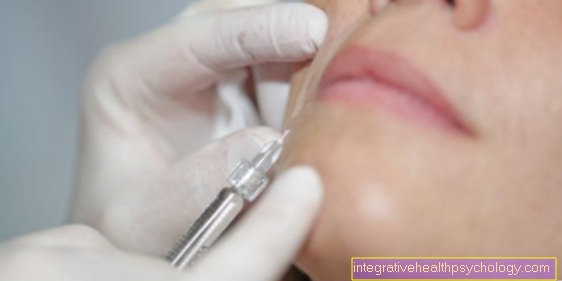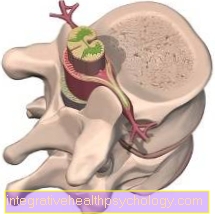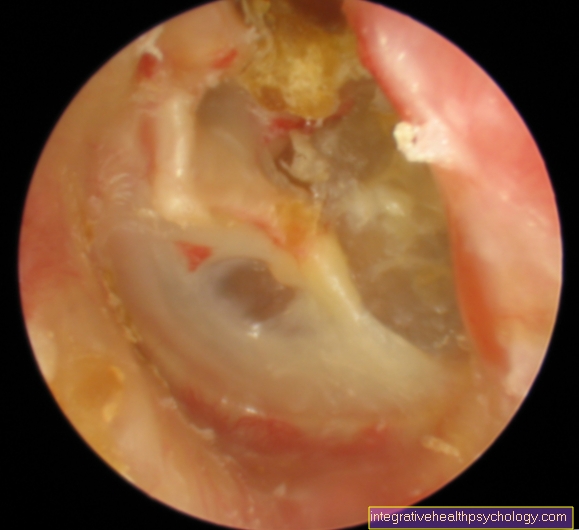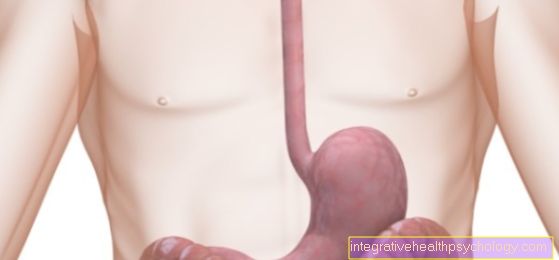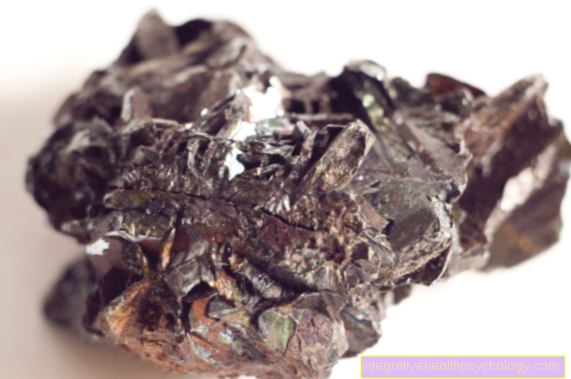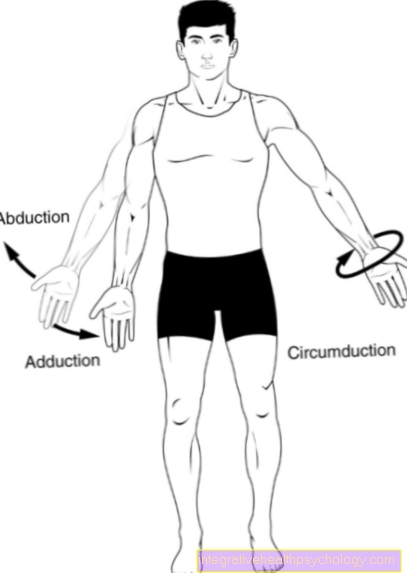The copper chain
What is a copper chain?
The copper chain is a hormone-free method of contraception.
The copper chain is a further development of the classic copper spiral.
It is a very safe method of contraception, with only 0.1 to 0.5 percent of women becoming pregnant within a year despite use.
The copper chain consists of a thread with several pieces of copper, which continuously release copper ions and thus prevent conception.
Replacing the copper chain is usually only necessary after five years of use.
Are you interested in other hormone-free contraception methods? Find out more about the topic on our overview page:
- Hormone-free contraception

safety
The safety of contraceptive methods is indicated with the Pearl Index.
The lower the value, the safer the contraceptive method.
A value of 100 means that all women tested will become pregnant within one year and a value of 0 means that no woman will become pregnant.
The pearl index for the copper chain is 0.1 to 0.5.
This means that the safety of the copper chain is over 99.5 percent.
Only one in 200 to 1000 women becomes pregnant despite the copper chain. This value roughly corresponds to the safety of the pill, if taken correctly.
Who is the copper chain suitable for?
Almost all women who are of childbearing age can use the copper chain.
Women who have had bad experiences with hormonal contraception often want hormone-free contraception, which applies to the copper chain.
Even young girls can already use the copper chain for contraception, as the chain is small and fits into every womb. In addition, the girls do not have to take regular medication.
Since the copper chain loses its effectiveness when it is removed and does not cause any cycle changes, this method of contraception is also suitable for women who want to have children later and can also be used between two pregnancies.
When breastfeeding, only hormone-free contraception methods should be used so that the hormones do not get into breast milk. The copper chain is one possibility.
However, after a caesarean section, there should be a three-month break before the copper chain is inserted.
Hormonal birth control methods are also contraindicated for certain chronic diseases and the copper chain offers an alternative.
These diseases include, for example, autoimmune diseases, tendency to thrombosis and cancer.
Vegans also like to use the copper chain, as animal components are used in both hormone preparations and condoms, which is not the case with the chain.
Are you interested in other hormone-free contraception methods? Find out more about the topic on our overview page:
- Hormone-free contraception
Who is the copper chain not suitable for?
Although the copper chain is well tolerated by most women, there are some contraindications to the use of this method of birth control.
- Women who suffer from very heavy and irregular bleeding and who develop other physical complaints during their period should first ask their gynecologist whether hormonal therapy can alleviate these symptoms.
- In addition, in some women the wall of the uterus is not thick enough to hold a copper chain in place. This can be the case after long-term hormonal treatment and should resolve on its own in most women.
In many cases, the insertion of the copper chain can be made up for later.
- As with many substances, the body can also develop an allergy to copper.
The immune system can overreact and the copper chain is not tolerated.
- In addition to allergies, there are also chronic diseases that exclude copper products.
This includes Wilson's disease. This is a copper storage disease in which copper cannot be broken down by the liver and builds up in the body.
Affected women have toxic copper deposits in many organs and are therefore not allowed to ingest additional copper. However, this would be possible if the copper chain were used and the copper chain is therefore not a suitable method of contraception for those affected.
The advantages of the copper chain
The copper chain offers several advantages over other contraceptive methods. The first benefit is that the copper chain is hormone-free.
As a result, the chain does not affect the woman's natural cycle.
In addition, the copper chain can also be used for many chronic diseases and can also be used well if you later wish to become pregnant.
The second advantage is the low Pearl Index, which indicates that the copper chain has a security of 99.5 to 99.9 percent. The copper chain is thus in a similar frame to the pill and well above the condom.
After a single use, the woman also has five years of rest and does not have to worry about contraception.
An application error by the woman, such as when taking the pill, is excluded, as the copper chain is used by a gynecologist and is then only checked regularly.
There are also no known interactions with other drugs.
Side effects are very rare even in comparison with the similar copper IUD and the copper chain is well tolerated by almost all women.
Since the copper chain lasts five years, it is significantly cheaper than the pill.
Find out about your alternatives in the choice of contraceptives:
- The mini pill
The disadvantages of the copper chain
Many women see the system as a disadvantage of the copper chain compared to other contraceptive methods.
The insertion of the copper chain is often described as uncomfortable and painful.
After the insertion, bleeding and pain or cramps can occur for several days.
Another disadvantage is that menstrual bleeding can be significantly heavier in the first few months and can last a few days longer.
This heavy bleeding can be accompanied by abdominal cramps and pain.
If this bleeding is too heavy or does not decrease after six months, it may be necessary to remove the copper chain.
In some cases, the copper chain also leads to an increased risk of inflammation of the uterus and fallopian tubes.
Even with a differently shaped uterus, the copper IUD can lead to increased pain and less security.
If a pregnancy occurs despite a copper chain, the likelihood of a so-called ectopic pregnancy is increased, which is a risk for the woman.
Although the copper chain is cheaper in direct comparison with the pill, the costs of around € 300 must initially be borne by yourself.
This is a disadvantage especially for young women, as the health insurance companies pay for the pill up to the age of 20.
These can be the side effects
The side effects of the copper chain are very similar to the side effects of the classic copper IUD. During the placement, the uterine wall can be injured and in extreme cases the copper chain can come to lie in the abdomen, where it has to be surgically removed.
The plant itself can be very painful. Immediately after the application, bleeding, cramps in the uterine muscles and pain can occur, which last for a few days.
In some women, the copper chain makes menstrual bleeding heavier and longer. The bleeding can also be accompanied by severe cramps and pain.
In some cases, there is also intermenstrual bleeding between the actual menstrual bleeding.
If this bleeding does not decrease after six months or if it is too strong from the start, the copper chain must be removed again.
The copper chain is associated with an increased risk of inflammation of the uterus and fallopian tubes. With a pregnancy, despite the copper chain, the probability of an ectopic pregnancy with all its risks is increased.
Can you feel the copper chain?
Most women do not feel the copper chain.
The copper chain is a thin thread that hangs freely in the uterus. For this reason, even young girls with a small uterus rarely feel the copper chain.
This differs from the IUD, which leads to irritation more often.
The woman can feel the thread, which reaches down into the vagina, with her fingers and thus carry out a position check independently. In doing so, however, the thread must never be pulled.
Can a copper chain make sterile?
Since the copper chain does not contain hormones, the effect is gone as soon as the copper chain is removed.
The chain has no effect on a woman's normal cycle and can also be used if she later wishes to have children.
Since the copper chain increases the likelihood of an ectopic pregnancy in the event of a pregnancy nonetheless, this can in very rare cases lead to infertility.
The injury to the uterus by the copper chain itself is so minor that no long-term effects are to be expected.
How is the copper chain used?
The copper chain consists of a thread on which four copper capsules are threaded. This should hang freely in the uterus after the application.
The installation is carried out by a specially trained gynecologist, as the installation of the copper chain is a little more complicated than the installation of the classic copper spiral.
Before inserting the copper chain, an ultrasound examination must be performed to measure the wall thickness and shape of the uterus.
Some gynecologists give a medication a few hours before the application, which dilates the cervix.
The vagina and cervix are then well disinfected to avoid inflammation. The uterus must then be stabilized with a clamp.
The copper chain itself is inserted into the uterus with an applicator. The end of the chain with a knot is pierced into the muscles of the uterine wall with a small needle.
The final fixation is done by the muscles themselves, but this takes a week.
Since the application is described by some women as very painful, the application can take place with the use of local anesthetics.
In the week after installation, the chain is not yet fully fixed and can therefore be ejected more easily.
How painful is that?
The creation of the copper chain is described by some women as very painful. There are different reasons for this:
The first cause of pain can be the stretching of the vagina and cervix. This is especially true for young girls as the vaginal entrance can be even narrower.
The actual application can also lead to pain, as the copper chain is inserted into the wall of the uterus with a small needle. Women react differently to the pain. After consultation with the gynecologist, the system can be carried out using local anesthetics.
A corresponding explanation should take place at a separate appointment so that the woman has time to think about whether an anesthetic is desired.
Fear of the pain associated with the application is the most common reason why women decide against the otherwise very safe copper chain contraceptive method.
Can the copper chain cause pain after insertion?
Immediately after inserting the copper chain, the woman may experience severe pain, bleeding and cramps for about a week.
However, this pain should subside after a few days.
When inserting it itself, the vagina and the cervix can be irritated and thus cause pain for a few days.
The copper chain can also lead to stomach cramps later on.
Since the copper chain is often associated with heavier menstrual bleeding, menstrual cramps are also increased.
If these increased symptoms do not improve within six months, the removal of the copper chain should be considered.
Since the copper chain is associated with an increased risk of inflammation, a gynecologist should be consulted if pain occurs suddenly.
costs
The cost of inserting a copper chain is around 250 to 400 euros.
Since the copper chain should last five years, the monthly costs are around five euros.
In comparison, the monthly cost of the pill is around ten to twenty euros, depending on the preparation.
Some gynecologists also offer installment payments for the system. The costs increase if the chain has to be removed or changed earlier than planned.
When does the health insurance company pay?
Contraceptives are medical products that must be paid for by the user.
In the case of minors, some health insurances cover the costs for the system, since the pill is also paid for up to the age of 20. In exceptional cases, such as after an abortion or in the case of proven hormone intolerance, some health insurance companies also pay for the copper chain beyond the age of 20.
In some cities, instead of health insurance, the Profamilia initiative pays the costs for a copper chain for socially disadvantaged women, sponsored students and trainees with grants.
What is the difference to the spiral?
The copper chain is often referred to as the further development of the classic spiral. The first difference between the spiral and the chain is the anchorage.
A copper chain is anchored in the wall of the uterus, while a spiral, due to its shape and small barbs, remains in the uterus without having a fixation. There are also different shapes of the spiral.
Some contain hormones and some are made of copper only. The copper chain is always hormone-free.
Find out about the relevant information on contraception with an IUD:
- spiral
Due to the shape of the copper chain, it can be used on a very small, young uterus, while young girls often complain of pain when wearing an IUD.
In the first time after it has been applied, the copper chain is more likely to be repulsed than the copper IUD, because the muscle must first be completely fixed. The wearing comfort of the copper chain is described as higher because there are no barbs in the uterus.
The other side effects, such as increased menstrual bleeding, are similar with the copper chain and the copper IUD. Which contraception method is more suitable for the individual should be discussed with the attending gynecologist.
What is the difference to the copper ball?
The copper ball is, similar to the copper chain, a thread with several copper balls. However, this thread curls up into a ball in the uterus and is too large to be expelled through the cervix. The copper ball can therefore do without a fixation and the application is less painful.
All other side effects are very similar to the copper chain. The cost of the copper ball is around 500 euros above the cost of the copper chain, but it is still one of the cheaper contraceptive methods.
Can you do an MRI with a copper chain?
Magnetic resonance tomography must not have any magnetic metals in the room, as these can be accelerated and lead to injuries.
Pure copper is not magnetic and therefore completely unproblematic in an MRI scan.
A copper chain is made of pure copper and is therefore not an obstacle to an MRI.
However, the doctor should be told about the copper chain, as otherwise the evaluation and interpretation of the images may be falsified.
What do I have to do if the copper chain has fallen out?
A copper chain is not yet fully fixed, especially in the first few days after application, as this has to be done by the muscles themselves.
For this reason, there is increased repulsion of the copper chain in the first few days.
If the woman notices this, she should see a gynecologist.
The copper chain can also slip out unnoticed when using the toilet. Immediately after slipping out, there is no more contraception.
For this reason, the situation should be checked after a few days or weeks. In addition to the copper chain, a condom should be used for contraception, especially at the beginning.
After slipping out, a new copper chain can be used immediately, but this is again associated with costs. The gynecologist checks whether there was a specific reason for the loss and whether it can be remedied.
Slipping out of the copper chain poses no danger for the woman. The place where the copper chain was attached heals spontaneously and without scarring.
Severe abdominal cramps can be a risk factor for slipping out.
If the copper chain is lost frequently, an alternative method of contraception should also be considered for financial reasons.
Is it possible to use it despite a later desire to become pregnant?
The copper chain works without hormones and does not interfere with the woman's natural cycle.
Pregnancy is therefore possible again immediately after removing the copper chain.
Long-term effects that can prevent pregnancy are significantly less common than with hormone preparations. The copper chain is also suitable for a break between two pregnancies.
The copper chain can therefore also be used without hesitation for young girls before family planning.
The GyneFix copper chain
Like all drugs and medical devices, the copper IUD has two names.
Once the name that describes the product, i.e. copper chain, and once the trade name that the manufacturers have given the product.
The copper chain is sold under the name Gynefix® and is protected by copyright.
This means that other manufacturers are not allowed to bring a product similar to the copper chain onto the market for a certain period of time.
Only when the patent expires can the copper chain be produced by other manufacturers.
Read our article about the GyneFix® copper chain.
Recommendations from the editorial team
- Everything about contraception
- The pill
- The spiral
- Everything about the topic of three-month injections
- Put the condom on properly












